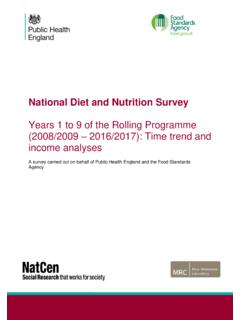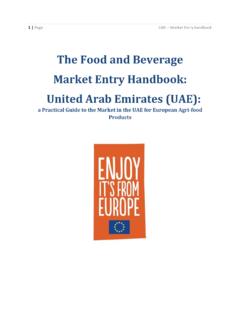Transcription of McCance and Widdowson’s The Composition of Foods ...
1 McCance and Widdowson's The Composition of Foods Integrated Dataset 2021. User guide 1. McCance and Widdowson's The Composition of Foods integrated dataset 2021. Contents Authors' acknowledgements .. 3. Introduction .. 4. Sources of data and methods of evaluation .. 4. Data formats .. 6. Details of nutrient data .. 9. Factors worksheet .. 9. Proximates worksheet .. 10. Inorganics 12. Vitamins worksheet .. 12. Vitamin fractions worksheet .. 14. Food 15. Front of pack' nutrition labelling .. 16. Tolerances for nutrient values declared on a label .. 17. Appendices .. 18. Appendix A: Main data 18. Appendix B: Food sub-group codes.
2 23. Appendix C: Acronyms, descriptions and units .. 27. 36. 2. McCance and Widdowson's The Composition of Foods integrated dataset 2021. Authors' acknowledgements We would like to thank colleagues who worked on previous versions of CoFID, which this version builds on, and/or provided advice on the 2021 dataset. Colleagues at Quadram Institute Bioscience Mark Roe and Rachel Berry. Colleagues at Public Health England Sakhi Dodhia, Melanie Farron-Wilson, Joanne McArdle, Danielle Weiner, Gillian Swan and Mark Bush. Colleagues at Department of Health and Social Care Hannah Koffman and Debby Webb. 3. McCance and Widdowson's The Composition of Foods integrated dataset 2021.
3 Introduction Public Health England (PHE) is responsible for maintaining data on the nutrient content of the UK food supply to support the National Diet and Nutrition Survey, and funds nutrient analysis of Foods commonly consumed in the UK. Data from this work, and complementary data from other sources are published as McCance and Widdowson's The Composition of Foods ' the UK food Composition tables. Previous data have been published in book form as a series of supplements, each containing extensive data on a specific food group, and also as the summary editions. The Composition of Foods Integrated Dataset (CoFID) was first published in 2008 and brought together for the first time all the available data in electronic format as a single, consolidated dataset.
4 The 2015 version was an update of the original published in 2008. and included all the new and recently reviewed data available at that point. Foods calculated by recipe or calculated based on another food (for example, Foods weighed with waste) were recalculated to include the most recent data for ingredients. A subset of the 2015 data were also published in book form as McCance and Widdowson's The Composition of Foods seventh summary edition. A further update of CoFID in 2019. included data from a 2015 fruit and vegetable nutrient analysis project and new and revised data on whole and toasted almonds. This updated version (2021) of CoFID.
5 Incorporates data from a 2020 report on nutrient analysis of key cuts of pork including updates for associated Foods and recipes within the pork section. Data on the following Foods have been corrected: vitamin C in watercress; iodine in soya yogurt; and vitamin E, sugars and biotin in boiled and steamed sweet potato. All other values remain unchanged from CoFID (2019). Sources of data and methods of evaluation It is essential that food Composition data are regularly updated for a number of reasons. New fresh, ambient, frozen, and processed Foods are introduced and the nutrient content of existing Foods change.
6 This can happen when there are new varieties or new sources of supply for the raw materials. New farming practices can affect the nutritional value of both plant and animal products. New manufacturing practices, including changes in the type and amounts of ingredients, and changes in fortification practice can affect the content of processed Foods . Many Foods have been reformulated in line with government public health initiatives, including reductions in the amount of fat, trans fatty acids, saturated fat, sugar and salt added. Methods of preparation and cooking in the home also change. The analytical survey reports from 2011 onwards are available to download in electronic form.
7 4. McCance and Widdowson's The Composition of Foods integrated dataset 2021. Earlier reports can be requested from Food Databanks National Cability (FDNC). These reports comprise raw laboratory data and have not been evaluated to the same extent as data incorporated into CoFID. The Composition of Foods series of publications in book form are listed below: Cereals and Cereal Products, supplement (1988). Milk Products and Eggs, supplement (1989). Vegetables, Herbs and Spices, supplement (1991). Fifth summary Edition (1991). fruit and Nuts, supplement (1992). Vegetable Dishes, supplement (1992). Fish and Fish Products, supplement (1993).
8 Miscellaneous Foods , supplement (1994). Meat, Poultry and Game, supplement (1995). Meat Products and Dishes, supplement (1996). Fatty Acids, supplement (1998). Sixth summary Edition (2002). Seventh summary Edition (2015). Many of the values included in CoFID have been taken from the seventh summary edition and detailed supplements, themselves mainly derived from the analytical surveys programme. All the data in the supplements were included in the original version of CoFID. published in 2008. The data were extensively revised and updated for the 2015 revision of CoFID some further revisions were made for the 2019 version, mainly to fruit and vegetables.
9 Additional revisions were made to incorporate data on pork in the latest 2021. dataset The main data source for each food is provided, where known, in the main data reference' column and refers to the references provided in Appendix A, which lists the reports and scientific literature from which data were taken. Some Foods that were included in the 2008 CoFID have not been reviewed or validated in the 2015, 2019 or 2021 update and those Foods are published separately in a file containing data for old' Foods . This data can be used in addition to the 2021 dataset, but users should be aware that the values for some nutrients may not represent those Foods as currently consumed.
10 Where the values in the tables were derived by direct analysis of the Foods , care was taken when designing sampling protocols to ensure that the Foods analysed were representative of those consumed by the UK population. For most Foods a number of samples were purchased at different shops, supermarkets or other retail outlets, and, where appropriate, foodservice outlets or catering suppliers. Samples analysed were composite samples, consisting of equal quantities of each sub-sample purchased. 5. McCance and Widdowson's The Composition of Foods integrated dataset 2021. When the composite sample was made up from a number of different brands of food, the proportion of the individual brands purchased was related to their relative shares of the retail market.















